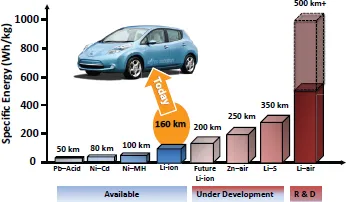
Li-s Batteries: The Challenges, Chemistry, Materials, And Future Perspectives
The Challenges, Chemistry, Materials and Future Perspectives
- 372 pages
- English
- ePUB (mobile friendly)
- Available on iOS & Android
Li-s Batteries: The Challenges, Chemistry, Materials, And Future Perspectives
The Challenges, Chemistry, Materials and Future Perspectives
About this book
-->
Lithium-sulfur (Li-S) batteries give us an alternative to the more prevalent lithium-ion (Li-ion) versions, and are known for their observed high energy densities. Systems using Li-S batteries are in early stages of development and commercialization however could potentially provide higher, safer levels of energy at significantly lower cost.
In this book the history, scientific background, challenges and future perspectives of the lithium-sulfur system are presented by experts in the field. Focus is on past and recent advances of each cell compartment responsible for the performance of the Li-S battery, and includes analysis of characterization tools, new designs and computational modeling. As a comprehensive review of current state-of-play, it is ideal for undergraduates, graduate students, researchers, physicists, chemists and materials scientists interested in energy storage, material science and electrochemistry.
--> -->
Contents:
- Introduction to Rechargeable Lithium-Sulfur Batteries (Rezan Demir-Cakan)
- Sulfur Cathode (Elton J Cairns and Yoon Hwa)
- The Use of Lithum (Poly)sulfide Species in Li-S Batteries (Rezan Demir-Cakan, Mathieu Morcrette and Jean-Marie Tarascon)
- Lithium-Sulfur Battery Electrolytes (Patrik Johansson, Rezan Demir-Cakan, Akitoshi Hayashi and Masahiro Tatsumisago)
- The Lithium Electrode Revisited Through the Prism of Li-S Batteries (Marine Cuisinier and Brian D Adams)
- Analytical Techniques for Lithium-Sulfur Batteries (Manu U M Patel and Robert Dominko)
- Other Sulfur Related Rechargeable Batteries: Recent Progress in Li-Se and Na-Se Batteries (Rui Xu, Tianpin Wu, Jun Lu and Khalil Amine)
- Computational Modeling of Lithium-Sulfur Batteries: Myths, Facts, and Controversies (Alejandro A Franco)
- Conclusion: Challenges and Future Directions (Elton J Cairns)
--> -->
Readership: Undergraduates, graduate students, researchers, physicists, chemists and materials scientists interested in energy storage, material science and electrochemistry.
-->Lithium-Sulphur;Lithium-Ion;Green Energy;Battery Power;Sulfur Cathode;Lithium Electrodes;Lithium Polysulfides Key Features:
- Provides current knowledge and recent concepts of Li-S batteries and highlights research of top international scientists in the field
- Designed for researchers and practitioners working with Li-S batteries, as well as an academic text for teaching and reading
- Authors are strongly engaged in the progress of Li-S batteries, and concentrate on the fundamental understandings and challenges surrounding their increased adoption
Frequently asked questions
- Essential is ideal for learners and professionals who enjoy exploring a wide range of subjects. Access the Essential Library with 800,000+ trusted titles and best-sellers across business, personal growth, and the humanities. Includes unlimited reading time and Standard Read Aloud voice.
- Complete: Perfect for advanced learners and researchers needing full, unrestricted access. Unlock 1.4M+ books across hundreds of subjects, including academic and specialized titles. The Complete Plan also includes advanced features like Premium Read Aloud and Research Assistant.
Please note we cannot support devices running on iOS 13 and Android 7 or earlier. Learn more about using the app.
Information
Chapter 1
Introduction to Rechargeable Lithium–Sulfur Batteries
1.1.Introduction and History of Lithium–Sulfur Batteries
1.1.1.Introduction

1.1.2.History of Li–S batteries
Table of contents
- Cover
- Halftitle
- Title
- Copyright
- Preface
- Contents
- About the Editor
- Chapter 1 Introduction to Rechargeable Lithium–Sulfur Batteries
- Chapter 2 Sulfur Cathode
- Chapter 3 The Use of Lithium (Poly)sulfide Species in Li–S Batteries
- Chapter 4 Lithium–Sulfur Battery Electrolytes
- Chapter 5 The Lithium Electrode Revisited through the Prism of Li–S Batteries
- Chapter 6 Analytical Techniques for Lithium–Sulfur Batteries
- Chapter 7 Other Sulfur Related Rechargeable Batteries: Recent Progress in Li–Se and Na–Se Batteries
- Chapter 8 Computational Modeling of Lithium–Sulfur Batteries: Myths, Facts, and Controversies
- Chapter 9 Conclusion: Challenges and Future Directions
- Index